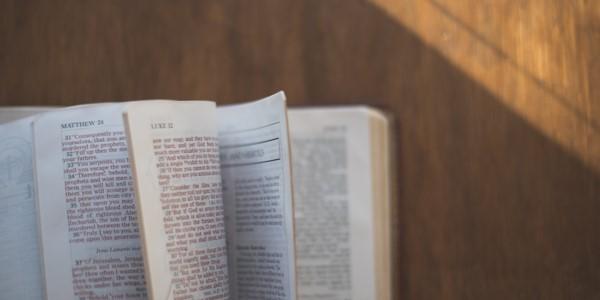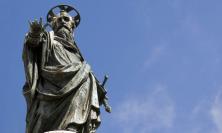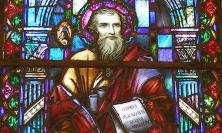Pope Francis has invited the whole Church to embark on a journey of reflection by convoking a Synod, under the title: ‘For a Synodal Church: Communion, Participation, and Mission’. The Preparatory Document that is intended to help all members of the Church reflect on that theme presents a scriptural pattern which, when ‘contemplated and explored in depth’, can allow the Church to ‘increasingly become what she is’: the dynamic in the gospels between Jesus, the crowd in its diversity and the apostles. Peter Edmonds SJ surveys how the evangelists portray each of those three parties, so that we may more fully consider what their relationship reveals about the nature of the Church.
The Preparatory Document of the Synod ‘For a Synodal Church’ summoned by Pope Francis contains paragraphs headed, ‘Listening to the Scriptures’ (§16-24). Apart from a section reflecting on the call of Cornelius, the centurion in Acts 10, these paragraphs concentrate on the gospels and in particular on three actors therein, namely Jesus, the crowds and the apostles. The remarks that follow concern the presentation of these three actors by the individual evangelists. How, then, do these three actors appear in Mark, Matthew, Luke and John?
The first actor: Jesus
The fact that we possess four gospels invites us to look at Jesus as the individual evangelists saw him. Just as four photographers can each provide an image of the same person, all different and yet all true, the four gospel writers each give us their special portrait of the Jesus who dominates their narratives.
Mark introduces him as the ‘Christ, the Son of God’ (1:1). Peter will be the first human being to acknowledge him as the Christ or ‘Messiah’ (8:29). The centurion at the cross will be the first human being to acknowledge the crucified Jesus as the Son of God (15:39).
Mark’s story gives us a Jesus both human and divine. His humanity shines out in the emotion he shows in the presence of a leper (1:41), in his anger at the hard-heartedness of the synagogue authorities (3:5), in his ignorance of the identity of the woman who touches him (5:30), in his hunger (11:12). As a true human being, he needs to pray, not only before his arrest in Gethsemane (14:32-42) but also at the end of his day of ministry in Capernaum (1:35) and after his feeding of the five thousand (6:46).
We view his divinity in his forgiving the sins of the paralysed man (2:5), in his power over nature typified by the storm (4:39), in his dominion over demons in their thousands in the Gadarene country (5:13), in his cure over disease where human medicine was helpless (5:26), in his dominion over death (5:41). Like God (Psalm 77:19), he walks on the sea (6:48). Finally, he is raised from the dead (16:6) when the readers of Mark, with Peter and his companions, are invited to meet him again in Galilee (16:7) and to experience his story and his teaching once more, this time in the light of his resurrection.
Matthew’s opening verse identifies Jesus as the ‘Son of David, the Son of Abraham’ (1:1). He fulfilled the expectations of both Jew and Gentile: Jewish people were looking for a new David who would fulfil the prophecy of Nathan (2 Samuel 7:13); in Abraham, all the nations, the Gentiles, would find a blessing (Genesis 12:3).
As for his mission, we find him ‘teaching in their synagogues and preaching the good news of the kingdom and healing every disease and every sickness among the people’ (4:23; 9:35). Jesus is the great teacher who challenges his readers through five long discourses explaining in different settings the wealth and nature of the kingdom of heaven (5:1-7:29; 9:35-10:42; 13:1-52; 18:1-35; 24:1-25:46).
Matthew’s Jesus is a majestic figure, worshipped by the Magi at the beginning of gospel (2:11) and by his disciples at its end (28:17). He engages in intimate conversation with his Father: ‘All things have been handed over to me by my Father’ (11:27). His Father was ready to send him ‘more than twelve legions of angels’ (26:53). Yet he is approachable, gentle and humble in heart: ‘my yoke is easy and my burden is light’ (11:30). His ministry mirrors that of Isaiah (12:17-21 quotes Isaiah 42:1-5). Like the servant of Isaiah, through his miracles on behalf of the sick, ‘he took our infirmities and bore our diseases’ (8:17 quotes Isaiah 53:4).
Matthew concludes with Jesus on a mountain in Galilee, applying to himself words from the prophet Daniel about the dominion and glory and kingship given to the Son of Man (Daniel 7:14). The risen Jesus now makes this his own: ‘All authority in heaven and earth has been given to me’ (28:18), not because he submitted to Satan as urged during his temptations (4:8-10), but because he accepted the will of his Father (26:39).
In Luke, angels inform us of the identity of Jesus. The angel Gabriel tells his mother that he will be Jesus, ‘the son of the Most High’ (1:32). An unnamed angel tells shepherds that today was born ‘a Saviour, who is the Messiah (Christ), the Lord’ (2:11). In his first domestic words in this gospel, Jesus speaks of his ‘Father’s house’ (2:49). His first public words quote Isaiah (61:1): he is the one on whom the Spirit of the Lord rests (4:18). He is, as the disappointed disciple on the Emmaus road said after Easter, ‘a prophet mighty in deed and word before God and all the people’ (24:19). After the raising of the widow’s son at Nain, the crowds cry, ‘a great prophet has arisen among us.’ (7:16)
The Jesus portrayed by Luke is a figure for imitation who embodies in himself qualities valued by every Christian. He is a person who prays. He enters into personal relationships with people of every class, even tax collectors and sinners (15:1). He dies, promising a place in his kingdom for a penitent criminal (23:42). As he died, he commended his spirit into the hands of his Father (23:46).
Luke’s Gospel gives us the longest account of Jesus’s final journey to Jerusalem (9:51-19:44). Always on the move, he instructs disciples, confronts critics, appeals to unresponsive crowds. Here we meet the Good Samaritan (10:29-37), the Prodigal Son and his father (15:11-32), the publican in the Temple (18:9-14) and Zacchaeus (19:1-10). He is a Jesus for the whole world.
John’s Gospel begins just as the entire Bible begins, ‘in the beginning’ (1:1 quotes Genesis 1:1). Jesus is a pre-existent figure. He was the word which became flesh (1:14). Through him came grace and truth (1:17). He told Nicodemus: ‘No one has ascended into heaven but he who descended from heaven, the Son of Man’ (3:13). He had glory with the Father before the foundation of the world (17:5, 24). Those who see him, see the glory of God (1:14). This is a Jesus who needs no transfiguration.
His marvellous deeds are called signs whose meaning is brought out in the dialogues and discourses that follow. An example is the long encounter between Jesus and the crowds that follows the Feeding of the Five Thousand (6:1-65). The sight restored to the man born blind is a symbol of spiritual sight (9:1-41). The life he restores to Lazarus is a symbol of the eternal life that he offers the world (11:1-44).
It is easy to identify John’s Jesus as one who was not human at all. This is to overlook how he was tired out by his journey sitting by the well where he met the woman of Samaria (4:6), how before he raised Lazarus, the Jews said of him: ‘See how he loved him’ (11:36). His washing the feet of his disciples is an expression of his human love for them (13:1). His dialogue with Pilate is a human encounter (18:33-39). His death on the cross is no make-believe (19:30).
The second actor: the crowd in its diversity
We read of the crowd in almost every chapter of Mark (the exceptions are chapters 1, 13 and 16). They sit around Jesus (3:32), they gather around him (4:1; 5:21). Jesus takes pity on them (8:2), they ‘were spellbound by his teaching’ (11:18), but they are never said to ‘repent and believe in the good news’, the first words which Jesus speaks in this gospel (1:15). They remain outsiders ‘for whom everything comes in parables, in order that they may indeed look but not perceive, and may listen and not understand’ (4:11-12). A crowd came with Judas ‘with swords and clubs’ to arrest Jesus (14:43). As Jesus hung on the cross: ‘Those who passed by, derided him’ (15:29). The crowd play no part in Mark’s resurrection chapter (16).
But admirable individuals emerge from the crowd, people who do or say something positive which all who follow the way of the kingdom (10:52) can admire and imitate. We call these the ‘little people’ of Mark’s gospel. These include women like the Syro-Phoenician woman (7:24-30), the widow in the temple (12:41-43) and the woman of Bethany (14:3-9); named men like Jairus (5:22-24, 35-43) and Bartimaeus; and unnamed men like the father of the epileptic boy (9:14-29) and the scribe in the temple (12:28-34). The reader can add to their number.
In Matthew, the audience for the Beatitudes and the Sermon on the Mount is a crowd consisting of ‘all the sick, those afflicted with various disease and pains, demoniacs, epileptics, and paralytics’ (4:24); before he feeds the five thousand, Jesus says. ‘I have compassion on the crowd’ (15:32). Jesus offers rest to ‘all that are weary and carrying heavy burdens’ (11:28).
In a time of crisis, Jesus reproached the lakeside cities of Chorazin and Bethsaida because they did not repent (11:20). Matthew’s crowd is notorious for its cry before Pilate: ‘His blood be on us and on our children’ (27:25). Yet in the final verses of the gospel, they are surely included among all the nations to whom the risen Jesus missions his disciples (28:19).
The ‘little people’ of Mark reappear in Matthew in briefer form. We can add to Mark’s list the gentile Magi (1:18-25) and the centurion whose faith Jesus praises (8:5-13). Mark’s centurion at the foot of the cross becomes in Matthew a leader of a chorus proclaiming: ‘Truly this man was God’s Son’ (27:54).
In Luke, the people of Nazareth reject the one ‘anointed to bring good news to the poor’ (4:18) but those in Capernaum ‘wanted to prevent him leaving them’ (4:42). After the raising of the son of the widow of Nain, the crowd glorified God, saying, ‘God has looked favourably on his people’ (7:16), echoing Zechariah (1:68). Likewise, after the cure of the blind man of Jericho, ‘all the people, when they saw it, praised God’ (18:43).
But later, as he sets out on his final journey to Jerusalem, Jesus rebukes the crowd, saying: ‘This generation is an evil generation’ (11:29); and elsewhere: ‘Unless you repent, you will all perish like they did’ (13:5). But some did respond. Tax collectors and sinners ‘were coming near to listen to him’ (15:1). Only Luke tells us that after the events of the passion, all the crowds ‘returned home, beating their breasts’ (23:48), a symbol of repentance.
In Luke, we meet again the ‘little people’ of Mark, with the exception of the Syro-Phoenician woman. He offers additional memorable positive characters, some in his infancy story such as Zechariah (1:5) and Elizabeth (1:41), Joseph (2:4) and the mother of Jesus (1:38), and the shepherds (2:8); others in Jesus’s public ministry such as the 72 disciples (10:1) and the grateful leper (17:16), the sinners and tax collectors (15:1); and others in Jesus’s parables, such as the Good Samaritan (10:33) and the Prodigal Son (15:12).
There are two chapters in John where the crowd is prominent; one could argue that in John there are two crowds. We meet the first from Galilee in his sixth chapter. This is the crowd identified with the five thousand fed by Jesus. They want to make him king (6:15). Jesus accuses them of being interested only in physical food rather than the bread of life, which he identifies with himself (6:26). Jesus’s teaching fails in its object; it leads his audience to dispute among themselves (6:52).
The second crowd is the crowd of his seventh chapter, set in Jerusalem. The result of their encounter with Jesus is again division because of him. Their belief in Jesus, such as it was, is dismissed by the Pharisees who say, ‘This crowd which does not know the law – they are accursed’ (7:49). Nonetheless, when Jesus enters Jerusalem for the festival, the crowd greets him with palms and cries of Hosanna (12:13). Their admiration lacks roots. Soon afterwards they cry for his crucifixion (19:15).
John’s interest is rather in individuals. Nicodemus, a leader among the Jews, comes to him by night (3:1) and remains an enigmatic figure who joins Joseph of Arimathea in burying Jesus (20:39). A foreigner, the Samaritan woman, becomes his evangelist (4:25). The man born blind becomes a model of spiritual as well as physical sight (9:39). We overhear Jesus’s intimate conversations with Martha and Mary, the sisters of Lazarus (11:27, 33). After his resurrection, he addresses Mary Magdalen by name (20:16).
The third actor: the apostles
Jesus is rarely alone in the gospel story. He is in the company of disciples, some of whom he will distinguish as apostles. Their portrayal, like that of Jesus, differs in each gospel. These variations both serve our curiosity and put out a message for our own discipleship.
Jesus’ first public action in Mark is to call four fishermen from their nets to become fishers of people (1:16-20); soon afterwards on a mountain top, he summons twelve to be apostles who were ‘to be with him’ (3:14). He sends them out on mission (6:7, 30). They accompany him, but they turn out to be frustrating companions whose conduct proves more often a warning rather than an example. Once while in the boat, Jesus complained: ‘Do you have eyes, and fail to see? Do you have ears, and fail to hear?’ (8:18). In the crisis of Jesus’s arrest, they all deserted Jesus and fled (14:50). Judas betrayed him (14:10) and Peter denied he ever knew him (14:71). But Jesus himself has the last word. He promises to meet them again in Galilee, even Peter the one who betrayed him three times. There they would see him (16:7). With their return to Galilee, they could start again.
Matthew devotes a chapter to the disciples’ call and mission (10:1-42). Matthew is kinder than Mark in his portrayal of them. He omits or modifies Mark’s negative reports. He reports that after Jesus’s rebuke of them in the boat, ‘they understood’ (16:12). Peter is named as the rock on which Jesus would build his church (16:18) and Peter is told that ‘you who have followed me will also sit on twelve thrones, judging the twelve tribes of Israel' (19:28). Nonetheless several times Jesus addressed them as people of ‘little faith’ (6:30; 8:26; 14:31). The audiences of the gospel are to recognise themselves in their story. Their final mission, solemnly entrusted to them by the risen Jesus, is to make disciples of all nations (28:19).
Luke retells the story of the call of Peter in dramatic fashion in language reminiscent of the call of Moses at the burning bush (Exodus 3:1-6) and of the call of Jeremiah to his task of a prophet (Jeremiah 1:4-8). Twice Jesus sends the disciples out on mission; the first is that of the twelve (9:1-6) and the second of the 72 (10:1-12). Jesus shows touching concern for his disciples. Before their call, he spends the whole night in prayer (6:12). At his final meal with them, he prays for Peter and instructs him to confirm his brethren (22:32). Their failures reported by Mark are softened or even omitted. There is no rebuke in the boat about eyes that fail to see or ears that fail to hear (12:1). Their flight at Jesus’s arrest is not mentioned.
John’s Gospel can be said to begin with two prologues, the first about Jesus, ‘the word made flesh’ (1:1-18), and the second about disciples (1:19-51). Andrew and a person unnamed, Simon Peter, Philip and Nathanael come to Jesus, spend time with him, learn about him, and share their news with their friends. At the beginning of the final chapter, seven are mentioned, three by name (21:1). They share bread with him (21:13) and Simon Peter is solemnly commissioned as shepherd of the lambs of Christ (21:15-17).
After the discourse on the Bread of Life, Peter, on behalf of the twelve, expresses their belief in him. ‘Lord, to whom can we go?’ (6:68). At the Last Supper, they are called ‘his own’ (13:1). If Jesus himself is the vine, they are its branches (15:5). If before they were his servants, now they are his friends (15:15). Later Jesus would call them his brothers (20:17). At his arrest, Jesus tells his captors, ‘If you are looking for me, let these men go.’ (18:8). After the resurrection, Thomas confesses Jesus as his Lord and his God (20:28). We must add to the list of disciples the mother of Jesus, the woman of faith present at Cana (2:5) who stands next to her son by the cross, a model disciple in the company of the anonymous disciple whom Jesus loved (19:25-26).
Paragraph 20 of the Preparatory Document for the Synod begins: ‘Jesus, the crowd in its diversity, the apostles: this is the imagery and the mystery that must be constantly contemplated and explored in depth so that the Church may increasingly become what she is’. These notes are offered as a help to such contemplation and exploration.
Peter Edmonds SJ is a member of the Corpus Christi Jesuit Community in Boscombe.
For further reading:
Peter Edmonds, Stories and Portraits, The Way Companion to the Synoptic Gospels (Way Books, 2018)






